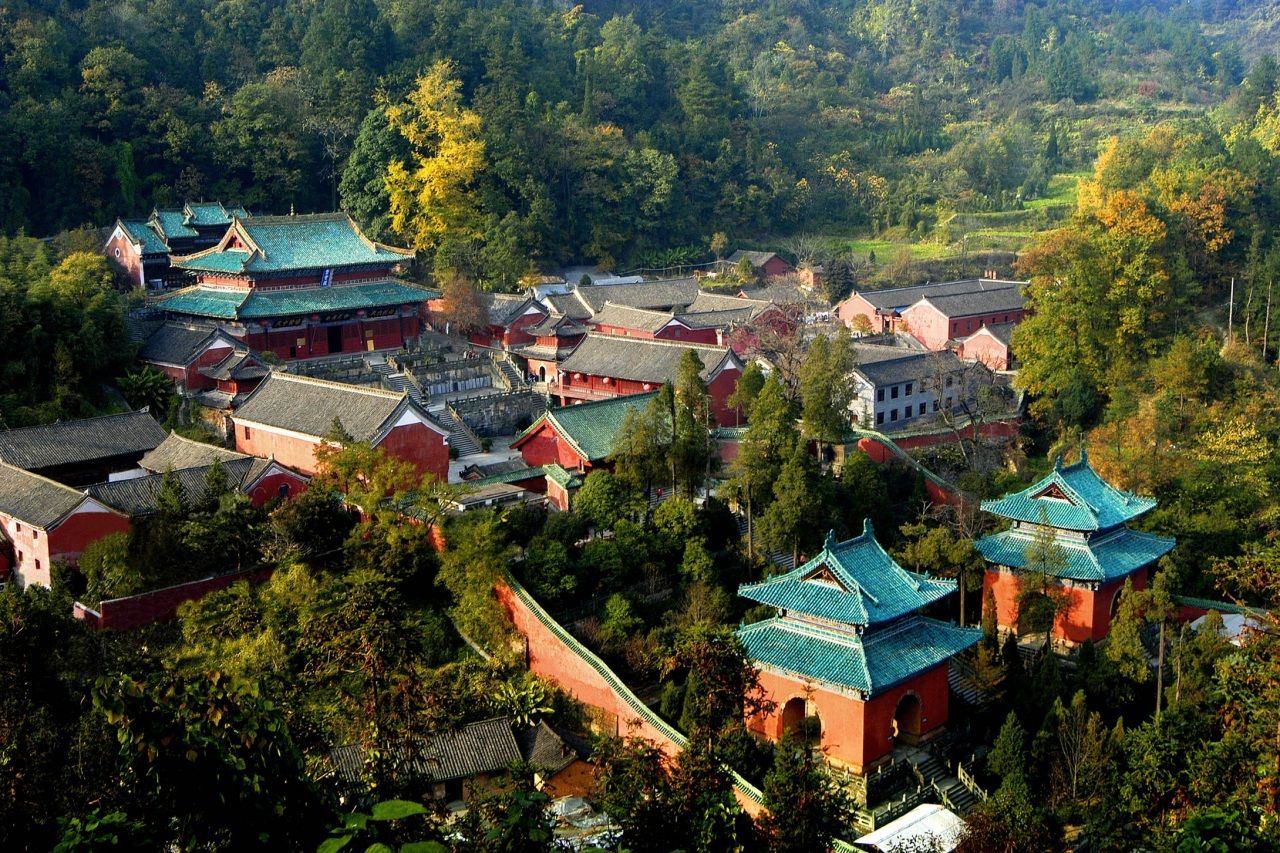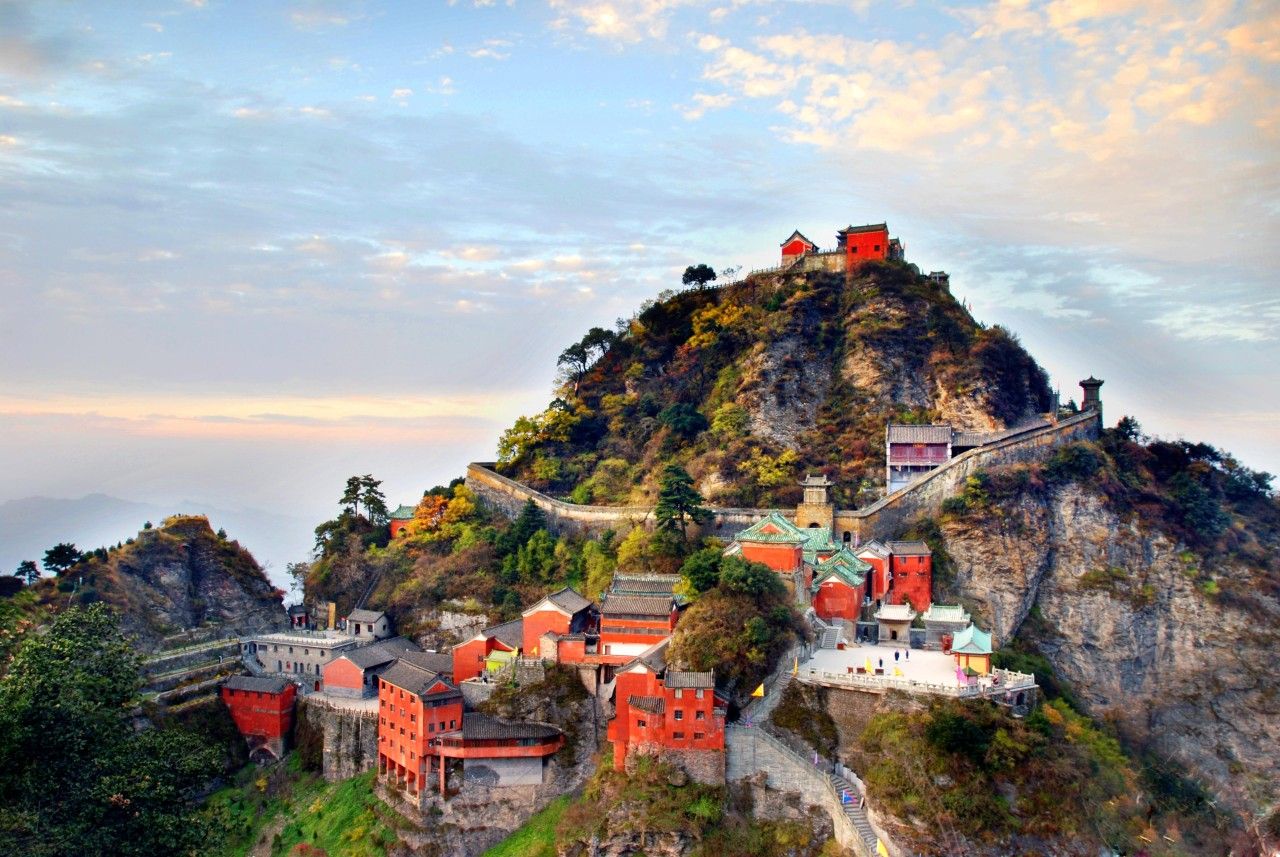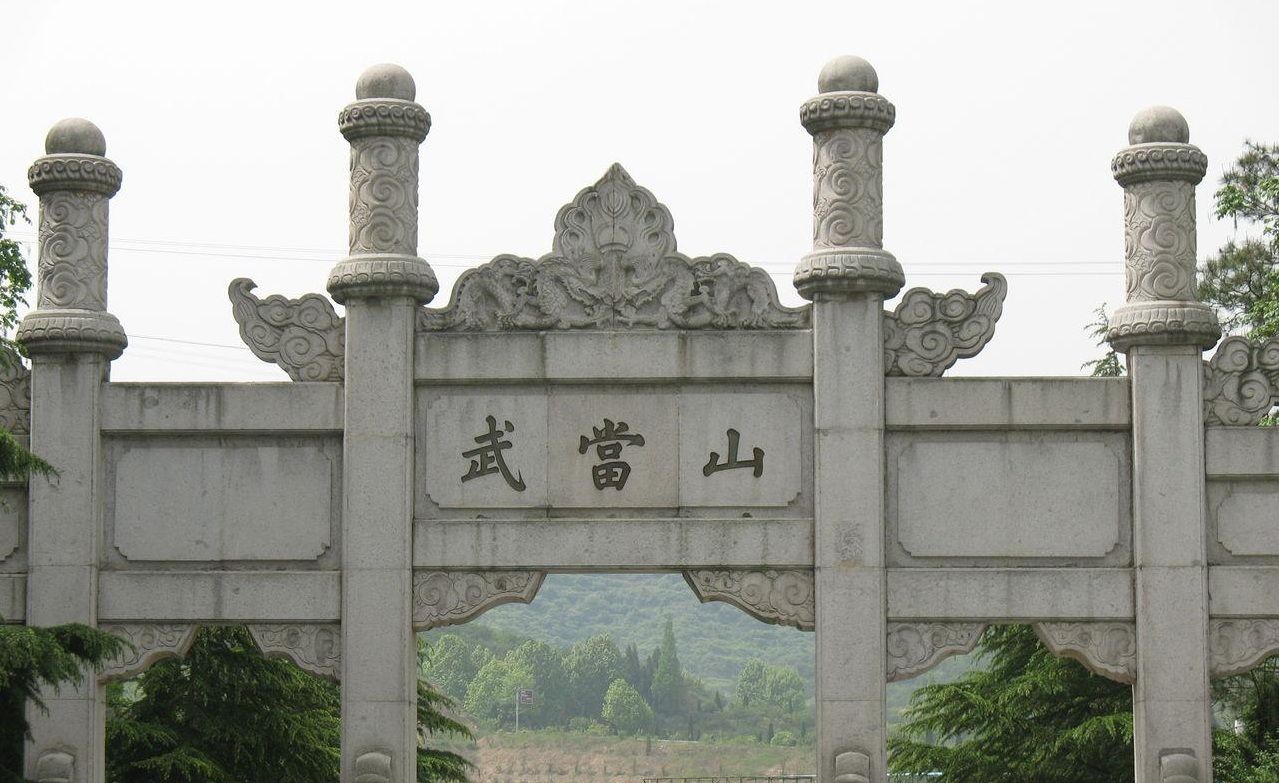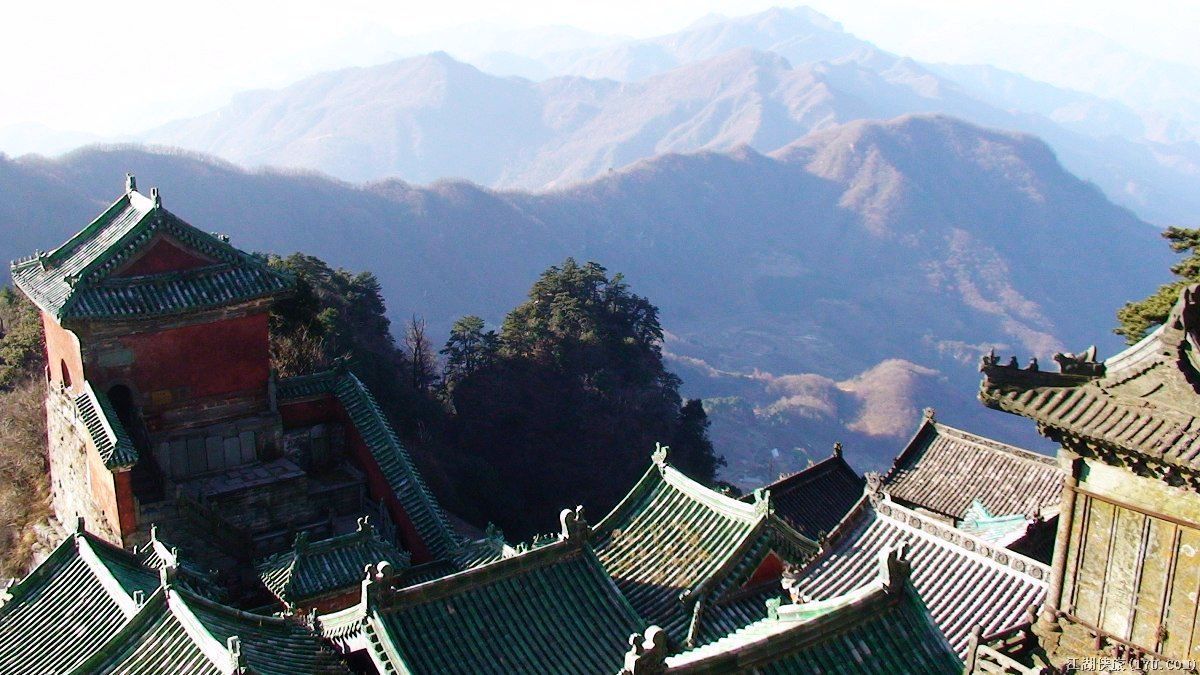

Die Wudang-Berge, heilige daoistische Berge im Nordwesten der Provinz Hubei in Zentralchina gelegen, auch "Heiligstes Gebirge unter dem Himmel" genannt, erstrecken sich über eine Fläche von 400 km.
In dieser schönen Landschaft finden sich 46 Haupttempel und Nonnenklöster, 72 Schreine und zahlreiche Höhlen und Einsiedeleien. Auf verwunschenen alten Steinwegen kann man den höchsten der 72 Gipfel, den 1600 m hohen Berg Tianzhu erklimmen, auf dessen Spitze sich der Goldene Tempel befindet.(Quelle: www.china-spezialreisen.de/wudang.html)
Die Wudang-Berge, Wudang Schan (chinesisch 武當山 / 武当山, Pinyin Wǔdāng Shān, W.-G. Wu Tang Shan, bekannt unter dem Namen „Taihe - 太和“ chinesisch 太和山, Pinyin Tàihé Shān, W.-G. T’ai Ho Shan ‚Berg der höchsten Harmonie / Berg des großen Friedens‘ oder „Xuan Yue“ chinesisch 玄岳, Pinyin Xuán Yuè ‚Berg der Mysterien‘), sind eine Bergregion im Nordwesten der chinesischen Provinz Hubei, nahe der Stadt Shiyan.
Das Gebiet umfasst ca. 400 km² und besteht aus 72 Gipfeln, der höchste mit 1612 m ist der Tianzhu (chinesisch 天柱峰, Pinyin Tiānzhù Fēng ‚Gipfel der Himmelspfeiler‘). Des Weiteren besticht die Landschaft mit 36 bizarren Felsen und 24 Tälern.
Mit seinen zahlreichen Bauwerken, Tempeln, Palästen, Klöstern, Brücken, Toren, Höhlen und Einsiedeleien ist Wudangshan ein berühmter heiliger Platz der daoistischen Religion und Anziehungspunkt für Pilger aus aller Welt.
武当山本名仙室山,一名太岳山,一名太和山,又名譧上山,东晋咸和中,历阳人谢允(谢罗公),辞掉罗县县令之职,隐遁于此山,故亦名谢罗山。[1]位于湖北省西北部十堰丹江口市境内,隶属于武当山旅游经济特区。汉江南岸,西北-东南走向,长260余公里,为大巴山脉东段分支,起自湖北、陕西两省边界,止于襄阳市南,隔汉江和大洪山遥对。武当山景区总面积312平方公里,是世界文化遗产、中国国家5A级旅游景区、国家重点风景名胜区和文物保护单位。为中国四大道教名山之首。(另三座为龙虎山、齐云山和青城山)。
武当山(ぶとうさん、ウーダンシャン)は、中華人民共和国湖北省十堰市にある山。又の名を太和山という。周囲400km、72峰からなる広大な山で、主峰は天柱峰(標高1612m)。山脈中には道観(道教寺院)群がある。
「玄天真武大帝」を奉る道教武当派と中国武術の武当拳の発祥地。道観は元の時代に戦火で焼失し、明の洪武帝の時代に再建された。道観と建物は1994年にユネスコ世界遺産(武当山古建築)となる。
日本では、映画『グリーン・デスティニー』中に物語の舞台として登場し、広く知られるようになった。
The Wudang Mountains (simplified Chinese: 武当山; traditional Chinese: 武當山; pinyin: Wǔdāng Shān) consist of a small mountain range in the northwestern part of Hubei, China, just south of Shiyan. They are home to a famous complex of Taoist temples and monasteries associated with the god Xuanwu. The Wudang Mountains are renowned for the practice of Tai chi and Taoism as the Taoist counterpart to the Shaolin Monastery,[1] which is affiliated with Chinese Chán Buddhism. The Wudang Mountains are one of the "Four Sacred Mountains of Taoism" in China, an important destination for Taoist pilgrimages.
Les monts Wudang (chinois simplifié : 武当山 ; chinois traditionnel : 武當山 ; pinyin : ; parfois écrit Wutang) ou montagnes de Wudang, sont une chaîne de montagnes au sud de la ville-préfecture de Shiyan dans la province du Hubei, en Chine.
Elle est considérée comme l'un des berceaux des arts martiaux internes taoïstes comme le taiji quan ou le bagua zhang qui se développèrent à partir du XVIIIe siècle. Les monts Wudang sont très connus et visités pour les nombreux monastères taoïstes que l'on peut y trouver. Ces monastères sont réputés comme centres de recherche d'apprentissage et de pratique de la méditation, des arts martiaux et de la médecine traditionnelle chinoise, et des pratiques de l'agriculture et des arts liés au taoïsme.
I Monti Wudang (in cinese: 武当山, Wǔdāng Shān), conosciuti anche col nome di Wu Tang Shan o semplicemente Wudang, sono una piccola catena montuosa che si trova nella provincia di Hubei, in Cina, poco a sud della città di Shiyan. Sono monti sacri e mete di pellegrinaggio per i fedeli taoisti e rappresentano una delle mete più rilevanti per il turismo cinese.
Queste montagne sono luoghi importanti sin dai tempi antichi per la presenza dei numerosi monasteri taoisti che vi si trovano, famosi come centri accademici di ricerca, insegnamento e pratica della meditazione, delle arti marziali cinesi, della medicina tradizionale cinese e delle pratiche e arti connesse all'agricoltura taoista. Già durante la dinastia Han le montagne attrassero l'attenzione dell'imperatore (fra il I e il III secolo). Durante la dinastia Tang (fra il 618 e il 907) venne costruito il primo tempio. Nel 1994 i templi delle montagne Wudang vennero inclusi nell'elenco dei Patrimoni dell'umanità dell'UNESCO.
Nel 1956 una grande quantità di statue antiche raffiguranti divinità e santi vennero fuse. Durante la rivoluzione culturale (1966 - 1976), con la quale venne attuata una capillare destituzione ed eliminazione delle religioni, i templi vennero svuotati, danneggiati, molti distrutti e dimenticati per decenni. Le attività religiose sono riprese di recente con il revival del Taoismo, alcuni templi, ricostruiti o restaurati, stanno tornando attivi e si stanno costituendo nuove comunità di monaci. Alcuni monasteri si sono organizzati in un'associazione, la Chiesa taoista dei monti Wudang. Nel giugno 2005 numerose comunità monastiche e maestri spirituali che si trasferirono in Taiwan per sfuggire alle persecuzioni sono stati autorizzati a fare ritorno presso i templi.
Fra gli edifici, costruiti ed ampliati soprattutto durante la dinastia Ming, si trovano costruzioni risalenti al VII secolo. Il complesso templare ha una grande valenza artistica, in quanto esprime l'apogeo raggiunto dall'arte e architettura cinese in un periodo di circa 1.000 anni.
Los montes Wudang (chino tradicional: 武當山, chino simplificado: 武当山, pinyin: Wǔdāng shān) se encuentran en el noroeste de la provincia de Hubei, en China. Su cumbre principal es llamada Tianzhu (Pilar del Cielo) y destaca entre los 72 picos que la rodean. El Conjunto de edificios antiguos de las montañas de Wudang fueron declarados patrimonio de la humanidad por la Unesco en el año 1994.
Se cree que en estos montes se originaron algunos estilos de artes marciales relacionados con el taoísmo, y se destacan el Wudangquan o Wudai Pai o estilo de lucha Wudang, y otros estilos relacionados, por ejemplo, Pa Kua Chuan, Ba Ji Quan, Tai Chi Chuan, etc. La leyenda atribuye a la región de los Montes de Wudang el origen de los estilos internos de las artes marciales chinas.
Los Montes Wudang destacan por ser el núcleo de templos taoístas y por su tradición histórica de maestros relevantes del taoísmo y de la medicina tradicional china .
Уданшань (кит. упр. 武当山, пиньинь: Wǔdāng Shān, палл.: Уданшань), гора Удан — небольшой горный хребет в провинции Хубэй, который находится недалеко от промышленного города Шиянь и около 120 км от города Сянфань.
Горы Уданшань знамениты своими даосскими монастырями и храмами, здесь был даосский университет, в котором исследовалась медицина, фармакология, системы питания, медитация и боевые искусства.







 Religion
Religion
 Vacation and Travel
Vacation and Travel
 World Heritage
World Heritage





